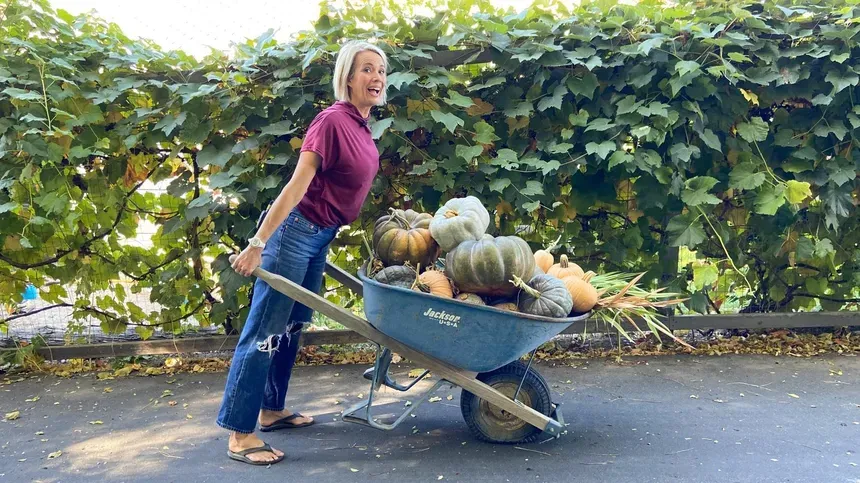Modern Gardener
How to Propagate Mums from Cuttings
Episode 109 | 7m 39sVideo has Closed Captions
Help your mums survive winter by using and propagating cuttings!
Help your chrysanthemums survive winter by using cuttings! If you're a cheap gardener like Cynthia, you'll love this easy method of propagating fall mums. Works for both annuals and perennials.
Problems with Closed Captions? Closed Captioning Feedback
Problems with Closed Captions? Closed Captioning Feedback
Modern Gardener is a local public television program presented by PBS Utah
Modern Gardener
How to Propagate Mums from Cuttings
Episode 109 | 7m 39sVideo has Closed Captions
Help your chrysanthemums survive winter by using cuttings! If you're a cheap gardener like Cynthia, you'll love this easy method of propagating fall mums. Works for both annuals and perennials.
Problems with Closed Captions? Closed Captioning Feedback
How to Watch Modern Gardener
Modern Gardener is available to stream on pbs.org and the free PBS App, available on iPhone, Apple TV, Android TV, Android smartphones, Amazon Fire TV, Amazon Fire Tablet, Roku, Samsung Smart TV, and Vizio.

Modern Gardener
Subscribe to the Modern Gardener YouTube channel for more videos and information on gardening, and share your gardening tips and stories in the comments section. Can't wait to GROW with you!Providing Support for PBS.org
Learn Moreabout PBS online sponsorship- Fall is fall mum season.
Everybody pulls out the mums and a lot of times I get super frustrated 'cause I'm a cheap gardener and I see people toss those fall mums in the garbage at the end of the day.
The fall mums that you buy at the store are most likely a perennial that you can easily plant anywhere in your yard and have those beautiful colors come up in the fall.
Or if you have annual mums, which I love to grow for their long stem, plus they have different faces, they're super happy, they're all super different, but they're expensive.
So fall mums, you can actually use their cuttings, super easy.
You just need a place to store them.
And when you do that next year, you can replant your mums.
And not only that, you can propagate 'em so that you can have extra of your favorite colors all throughout your garden.
So for example, this beautiful little sun gold mum started from one plant, and now it's all throughout my yard.
Not only in the back, but in the front.
Same with this wonderful purple variety that has such a fun face.
The yellow ones, all of my mums started from just one plant because I was a cheap gardener that was semi-patient.
I am just gonna stick with yellow because this is how I do it every year, thinking that I'm gonna actually get around to labeling.
I'm gonna look for a long stem, and I'm gonna cut down at the base and then off of this stem, I can use multiple cuts.
All right, are you ready to see how easy this is?
This is my bag that I will use if I am not ready to use the cuttings today.
You can cut and put them in the bag and just save 'em until you're ready.
It's probably about one to two weeks that you can keep 'em in a bag.
I have a moist paper towel that keeps that moisture in there and keeps the plant alive.
So what I'm gonna do, always label your plants.
I never do.
I don't have a label on here yet.
Learn from my mistakes that I have been doing for years.
That's why I have more yellows than white mums because I never label.
So I'm not gonna label, but be smarter than me and label your plant.
Okay, I'm gonna take my beautiful stems.
I'm gonna cut a few extras for good measure, and then we're gonna go move to my potting station.
You can do this for annual mums.
You can do this for perennial mums.
Frankly, you can do this for a lot of plants.
And that is, take a cutting and start rerouting it.
Okay, so what I do is I like to cut the bottom end on a diagonal so I know which one's bottom, and then I cut the top flat.
So I'll cut a fresh cut here on the bottom, and I'll cut the top flat.
And I do about three inches on my stem.
So I'm gonna cut it at a diagonal, make sure I get a couple leaf nodes.
I'm gonna cut that one flat.
I'm gonna take that leaf off.
Cut.
Make this one flat.
I'm not going to plant with the flowers.
I'm gonna take all the flowers off.
I'm just looking for the stem.
Okay, so now I have these little clippings.
I'm gonna pull off most of the leaves.
I'll probably leave two to three leaves, and just so that the energy goes into making more roots, I cut the leaf off, so I have one cutting.
Remember I haven't labeled this and that's really dumb so don't be like me and label your trays.
Cut, cut, cut.
Okay.
Now honestly, you can probably stick it in the ground and you'd have like a 50% chance of it rooting, but I like to use a take root or just any kind of rooting hormone.
It is super easy to find.
Any garden store will most likely carry it.
You can find it anywhere online, and I don't need very much, just a little bit of powder.
I'm not going to dip it into the actual jar 'cause I don't want to transfer any bacteria or anything wet that would grow something that's not a mum.
Okay, I'm just gonna take a little bit of powder, do the bottom, tap it.
I'm putting it into wet soil, and I'm just gonna plant them in.
Now because it's not spring, and I'm not ready to plant these out, I'll put my lid on top, and I will put it somewhere warm just to get them going.
Now it depends on you.
Sometimes I will just dig up the plant, and I will leave it in my garage until I'm ready to plant it.
Sometimes, I want these guys to be really big and vibrant before I put 'em in the ground.
So I will bring them in, especially when it's really cold.
If you have a more or less climatized garage, they'll be fine.
If you have a lean to like me that like everything freezes in it, bring it in during December, January, just put it in a dark space or you can put it up against the light, and let them stay warm until it's time to plant.
They will look really sad like they're about to die right before they take off.
So if they're all like drooping and like dying, give them like one more week, and they'll perk back up.
If they perk back up, you know that you have a plant that took.
If it continues to die, it's dead.
So make sure that you have a bunch just in case some of them don't make it.
It'll take 'em about two to three weeks to root usually.
I like to give it maybe four weeks to really get some established roots.
And once that has taken place, then we can put it into dormancy for winter.
So you wanna make sure when you're doing dormancy, that you just, you don't have to have the light on all the time.
If you're wanting 'em to grow, then you're gonna be keeping the light on.
But they can kind of go in a darker area.
A real chill basement works.
They do need light probably a couple hours a day if you're already put it in a light window or somewhere that it can get some light.
As far as watering goes, just when it starts getting really dry, so every two, four days.
It really just depends on kind of how dry the surface is.
The great thing is mums are super hardy, so you really, it's really hard to kill 'em.
Again, these are my annual mums.
These are the ones that aren't going to come back year after year, like the perennial ones that you most likely are gonna buy in the grocery store.
These ones are specialty mums that were expensive.
So I wanna save money and not only save money, but almost like make money by making more plants.
So with annual mums, they will not last in Utah winters.
It's too cold.
That is why I'm gonna take some cuttings now, and I'm going to save them and I will propagate them.
So now I even have more plants to plant next spring.
Thanks for watching, and make sure you hit that subscribe button.
(bright music)
Support for PBS provided by:
Modern Gardener is a local public television program presented by PBS Utah











